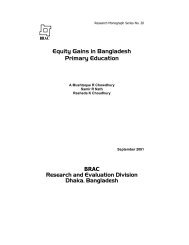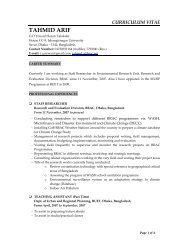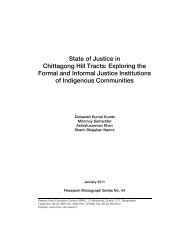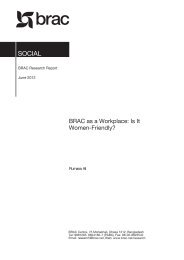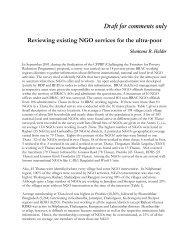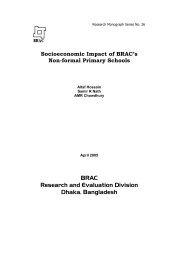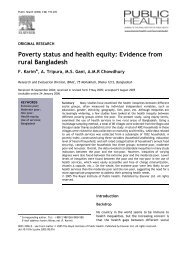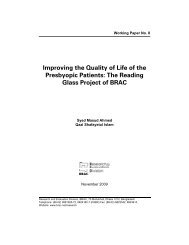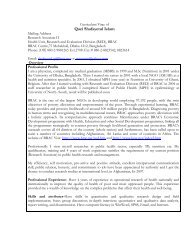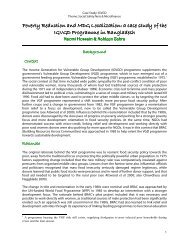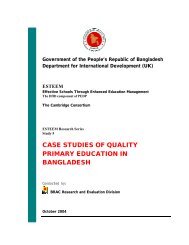Combining health and social protection measures to reach the ultra ...
Combining health and social protection measures to reach the ultra ...
Combining health and social protection measures to reach the ultra ...
Create successful ePaper yourself
Turn your PDF publications into a flip-book with our unique Google optimized e-Paper software.
Access <strong>to</strong> <strong>health</strong><br />
Senior Research Fellow for <strong>the</strong> global Commission on Social<br />
Determinants of Health, based at <strong>the</strong> International Institute for<br />
Society <strong>and</strong> Health, University College London. Prior <strong>to</strong> this, Dr<br />
Houweling worked at <strong>the</strong> Department of Public Health at<br />
ErasmusMC University Medical Center Rotterdam, <strong>the</strong> Ne<strong>the</strong>rl<strong>and</strong>s,<br />
where she did research on socio-economic inequalities in <strong>health</strong>, in<br />
particular in low- <strong>and</strong> middle-income countries. She was also<br />
involved in a study on <strong>health</strong> inequalities for <strong>the</strong> World Bank <strong>and</strong> in<br />
a technical consultation on <strong>health</strong> inequalities at World Health<br />
Organization (WHO) Geneva, Switzerl<strong>and</strong>. She obtained her PhD<br />
degree in September 2007 at Erasmus University Rotterdam, on a<br />
study on socio-economic inequalities in childhood mortality in low<strong>and</strong><br />
middle-income countries.<br />
Sebastian Taylor is a Senior Research Fellow for <strong>the</strong> global<br />
Commission on Social Determinants of Health, based at <strong>the</strong><br />
Institute for International Society <strong>and</strong> Health, University College<br />
London. Since 1992, much of his work has been in designing,<br />
managing <strong>and</strong> evaluating complex humanitarian <strong>and</strong><br />
developmental programmes. He has worked extensively in China,<br />
Laos, India, Pakistan, Nigeria, Egypt <strong>and</strong> Somalia. With a growing<br />
focus on <strong>health</strong> action in resource-poor settings, Dr Taylor worked<br />
with <strong>the</strong> Polio Eradication Initiative from 2002 <strong>to</strong> 2004, <strong>and</strong><br />
retains strong research interests in both <strong>the</strong> politics of large-scale<br />
<strong>health</strong> interventions, <strong>and</strong> <strong>the</strong> political economy of policy-making in<br />
global <strong>and</strong> multilateral aid agencies.<br />
References<br />
1.<br />
Sachs J. Macroeconomics <strong>and</strong> Health: Investing in Health for Economic<br />
Development, 2001. Commission on Macroeconomics <strong>and</strong> Health.<br />
Geneva: World Health Organization.<br />
2.<br />
Dwyer J. Global <strong>health</strong> <strong>and</strong> justice. Bioethics, 2005, 19 (5-6): 460-75.<br />
3.<br />
Global Forum for Health Research. The 10/90 Report on Health Research<br />
2003–2004, 2004. Geneva: Global Forum for Health Research.<br />
4.<br />
Labonte R, Schrecker T, Gupta A. Health for some: death, disease <strong>and</strong><br />
disparity in a globalising era, 2005. Toron<strong>to</strong>: Centre for Social Justice.<br />
5.<br />
Baum F. Who cares about <strong>health</strong> for all in <strong>the</strong> 21st century? Journal of<br />
Epidemiology <strong>and</strong> Community Health, 59 (9): 714-715, 2005.<br />
6.<br />
Wilkinson R, Pickett K. Income inequality <strong>and</strong> <strong>health</strong>: a review <strong>and</strong><br />
explanation of <strong>the</strong> evidence, 2005.<br />
7.<br />
Ebrahim S, Smeeth L. Non-communicable diseases in low <strong>and</strong> middleincome<br />
countries: a priority or a distraction? International Journal of<br />
Epidemiology, 2005, 34 (5): 961-966.<br />
8.<br />
Choi BCK et al. Diseases of comfort: primary cause of death in <strong>the</strong> 22nd<br />
century. Journal of Epidemiology <strong>and</strong> Community Health, 2005, 59 (12):<br />
1030-1034.<br />
9.<br />
Ezzati M et al. Comparative Quantification of Health Risks: Global <strong>and</strong><br />
Regional Burden of Disease Attributable <strong>to</strong> Selected Major Risk Fac<strong>to</strong>rs,<br />
2004. Geneva: World Health Organization.<br />
10.<br />
Gwatkin D, Wagstaff A, Yazbeck A. Reaching <strong>the</strong> poor with <strong>health</strong>,<br />
nutrition <strong>and</strong> population services, 2005. Washing<strong>to</strong>n DC: The World<br />
Bank.<br />
11.<br />
Global Fund. The Global Fund <strong>to</strong> fight AIDS, tuberculosis <strong>and</strong> malaria.<br />
12.<br />
WHO. WHO 3 by 5 initiative.<br />
13.<br />
WHO. Roll back malaria partnership.<br />
14.<br />
United Nations. Millennium Development Goals, 2000.<br />
15.<br />
Monden C. Current <strong>and</strong> lifetime exposure <strong>to</strong> working conditions. Do <strong>the</strong>y<br />
explain educational differences in subjective <strong>health</strong>? Social Science &<br />
Medicine, 2005, 60: 2465-2476.<br />
16.<br />
Bartley M. Job insecurity <strong>and</strong> its effect on <strong>health</strong>. Journal of Epidemiology<br />
<strong>and</strong> Community Health, 2005, 59 (9): 718-719.<br />
17.<br />
Marmot M, Brunner E. Cohort Profile: The Whitehall II study.<br />
International Journal of Epidemiology, 2005, 34 (2): 251-256.<br />
18.<br />
Christensen C. World hunger: A structural approach. International<br />
Organization, 2002, 32 (3): 745-774.<br />
19.<br />
Marmot MG. Tackling <strong>health</strong> inequalities since <strong>the</strong> Acheson Inquiry. J<br />
Epidemiol Community Health 58 (4): 262-263, 2004.<br />
20.<br />
Alvarez-Dardet C, Ash<strong>to</strong>n JR. Inequalities goes global. Journal of<br />
Epidemiology <strong>and</strong> Community Health, 2004, 58 (4): 261-.<br />
21.<br />
Ostlin P, Braveman P, Dachs N. Priorities for research <strong>to</strong> take forward <strong>the</strong><br />
<strong>health</strong> equity policy agenda. Bulletin of <strong>the</strong> World Health Organization,<br />
2005, 83 (12): 948-53.<br />
22.<br />
Marmot M, Wilkinson R. Social Determinants of Health (2nd ed.), 2005.<br />
Oxford: Oxford University Press.<br />
23.<br />
Marmot M. Social determinants of <strong>health</strong> inequalities. The Lancet, 2005,<br />
365: 1099-1104.<br />
24.<br />
Jong-wook L. Public <strong>health</strong> is a <strong>social</strong> issue. The Lancet, 2005, 365:<br />
1005-1006.<br />
25.<br />
Pang T. Filling <strong>the</strong> gap between knowing <strong>and</strong> doing. Nature, 2003,<br />
426:383.<br />
26.<br />
Pang T, Gray M, Evans T. A 15th gr<strong>and</strong> challenge for global public <strong>health</strong>.<br />
The Lancet, 2006, 367 (9507): 284-286.<br />
27.<br />
Solar O, Irwin A. Towards a Conceptual Framework for Analysis <strong>and</strong><br />
Action on <strong>the</strong> Social Determinants of Health, 2005. Geneva:<br />
Commission on <strong>the</strong> Social Determinants of Health.<br />
Global Forum Update on Research for Health Volume 4 ✜ 053



